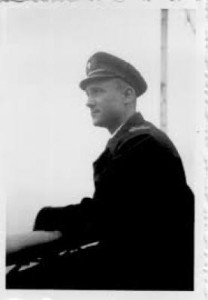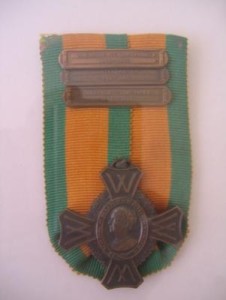The Dutch Contribution to the Defence of Australia in World War II
THE DUTCH CONTRIBUTION TO THE DEFENCE OF AUSTRALIA IN WORLD WAR TWO

Since November 2007 a plaque on the Pathway of Honor in Adelaide, South Australia, recognises the Dutch servicemen and women who joined the Australian forces in defending Australia during World War II. It was a gift from the Dutch community in South Australia.
It is not always realised that the Dutch made a considerable contribution to the defense of Australia. They fought alongside Australians against the Japanese during the dark days of 1942-43 and continued to fight until the Pacific War was over.
The most important Dutch contribution was the supply of sea-going vessels from the Royal Netherlands Navy and the Dutch merchant fleet. Indeed the Dutch had more merchant ships in Australia than other allies (USA, Australia, New Zealand and England) combined.
One of these merchant ships was the VNS (United Dutch Shipping) vessel MS Abbekerk.
Adriaan Willem Kik, then 21, was 4th engineer on the MS Abbekerk at the start of the World War II. In 2000 he documented his war-time memories on this vessel. This is an edited extract from the memoir, The Long Voyage, describing the Abbekerk’s hazardous journey from Scotland with a full and volatile cargo of weapons of various kinds. The ship’s destination was Singapore but the journey ends in Western Australia, still carrying a considerable amount of its original cargo and filled to capacity with evacuees from the Dutch East Indies (Indonesia).
FROM “THE LONG VOYAGE”

At long last we arrived in Singapore. I can remember quite well. When I stepped on deck to have a look at the steering machine at the stern, I saw a fighter plane falling out of the sky some sixty metres from the ship. That created a large water fountain and when that had come down the plane was nowhere to be seen. When you think about it, you see a human being killed right in front of your eyes. An Englishman, a Dutchman or a Jap? To be honest I did not give it much thought. I thought about the cargo in the ship and our absolutely hopeless position against an enormously outnumbered enemy force in the air.
We were ordered to anchor half a kilometre from any other ship and even further from the city. A well aimed bomb falling on our ship and all the other ships could have gone to the scrapheap.
On every day that followed Singapore was under aerial attack. At nine a.m.
(you could set your watch by it) thirty bombers flew right above our ship on their way to bomb Singapore. In great haste the Chinese dockworkers unloaded the Spitfires into barges tied alongside our ship, which then took the Chinese and aircraft ashore. Later we heard that five days after assembly they were all lost, shot down or destroyed on the ground. We could do nothing but watch the sky and wonder whether they would pick on us or go to the city again.
Not a single bomb came our way, but we were all stressed out for sure.
The second day a few barges with the Chinese workers came alongside to unload our cargo. The hatches were opened by our crew while the dockworkers went down the staircases to have a look at the cargo. Often I have heard a number of Chinese talk together, but the talk of some fifty already nervous and very frightened dockworkers was something else.
The boss of the Chinese went quickly to the Captain and let him know in perfect English that his men were not prepared to work in this warehouse of bombs and they returned straight away on one of the barges to the not so safe shore. These were the last Chinese we saw in Singapore.
Now we had a life-size problem. Everybody could see a mile off that there was never going to be someone to unload this dangerous cargo. If there was anyone who wanted to get rid of it, it was the crew. Communication with the shore was poor. Going there in our motor launch was the only way.
Chaos reigned all over the city. Nobody cared about any of the ships at anchor, The Japanese came closer and closer to Singapore and the English Army retreated slowly towards this city.
The captain asked the bosun if the sailors would agree to unload the bombs. They were prepared to do this; even the English gunners onboard volunteered to help. And so a number of bombs from every hold finished up in the barges alongside.
I can not remember how long it took before the barges were full but at a guess it was two to three days. After this the shipping agent had the a cargo towed away. We continued to stay at anchor. Every day the bombardments were getting heavier. The smoke of the fires ashore now continued to billow up all day. More and more planes were passing overhead.
After four weeks, when the Japanese were really close, the Captain once again boarded his motor launch to go ashore, this time to make telephone contact with the Dutch government in Batavia (now called Jakarta). The result was that we could leave Singapore. With renewed vigour the ship was readied for sea and to steam southwards at full speed. If we had had paddles we would all have helped to speed the ship along and away from Singapore.
What was in store for us? We found out soon enough! We sailed to Oosthaven on Lampung Bay on the southernmost point of the island of Sumatra where we anchored between a couple of islands in the bay. Here it was restful. We floated peacefully in the calm, very quiet and clear waters in beautiful green surroundings. We were moored next to a gun boat from the Dutch Navy called Soemba.
We received the unhappy order from Batavia that our three anti-aircraft guns, as well as the English gunners, had to be put ashore at once and transported northwards. It transpired that the Japs had already landed there. This came as a bolt out of the blue. The English soldiers were a nice group of guys and had become very much part of the crew. Also, all of a sudden we lost our entire anti aircraft capability. We were all shocked. We could do nothing better than shake their hands and wish them the best of good luck.
To prevent the barges in Oosthaven from falling into enemy hands we were ordered to sink them. The captain had again been in contact with Batavia to find out what in heaven’s name had to be done with the ship’s cargo because we were still loaded with ammunition in three quarters of the holds.
The situation was very grim everywhere and nobody knew what to tell us. I believe that there was no use for the bombs because we did not have any aeroplanes left. A day later barges came alongside with the order that they had to be loaded with the ammunition out of our holds, afterwards to be filled with the cooling water from the ship’s engines and sunk. All to be done by our own crew.
And thus all available barges, brimful with ammunition, were sunk. On the horizon we could see the smoke of the torched plantations. Again the Japs came too close for comfort. Across the whole of the Dutch East Indies there were landings and bombardments. Singapore had fallen and that was only a small part of the total operations. In all areas the Japs were superior. Resistance was nil. Everywhere there was total chaos. Only on the island of Java there were no Japs; but it was being bombed.
Yet in Batavia they were thinking about us. On 17th February 1942, the message was received that we had to speed to the harbour of Tjilatjap on the south side of Java.
We found the harbour brimful of ships. Large freighters, a couple of small passenger ships and a number of Navy vessels of differing nationalities. Without delay the hatches were opened and in great haste the ammunition was being unloaded. At the same time a gang of workers came aboard who, clearly in great haste, started to build a long row of latrines along the railing above a wide gutter which led overboard. They brought kitchen materials and food on board.
It was not long before we were told what we could expect. We were being prepared as an evacuation ship for the personnel of the forces. Members of the Army, Air Force and Navy of many different nations were to be ferried to Australia. We thought: “you need an entire fleet for this” and could not wait to see it.
We saw ships coming and going, the departing ships loaded to the hilt with refugees. One day all Navy vessels which were in the harbour left. Later we found out they had sailed to the Java Sea where on 28th February and 1st March they did battle with the Japanese fleet and suffered severe losses.
On 27th February, the day before the battle, all the ships in the harbour were ordered to leave for either Ceylon or Australia by evening. This created a great urgency, not only for the people unloading the ammunition but even more so for the refugees who were still on the way to our ship.
The unloading of the ammo was stopped. We found that the bottom holds were still loaded to the top. The hatches could just be closed without divulging what was underneath. During the day the men came aboard. A more diverse lot I have never seen. Aircraft crews still wearing their thick woollen jackets, a few high and a lot more lower officers, soldiers and sailors, both with and without weapons, and then some civilians, many with worried and tired faces. Well what can you expect? Most had left family behind and all faced a dangerous and uncertain future. They were spread over the entire length of the ship as well as in the top holds; everybody was given a camp bed. For most it was not easy. They had to leave, unprepared and hastily, very familiar surroundings and were literally plonked into the hold of a freighter, not a particularly well placed area to escape from in case of an emergency.
And so we went at a snail’s pace. On that same day a total of 24 big and small ships, amongst which were the Zaandam and the Jagersfontein, departed from the Tjilatjap harbour with the knowledge that the sea between them and their destination was infiltrated with Japanese warships, aircraft carriers and many submarines.
The captains had to decide their own course to steer and engines were stretched to the limit. None of the passengers knew that in the bottom hold there were a couple of thousand tons of ammunition. An unbelievable number of S.O.S. signals we received from ships sailing in our vicinity. All were about attacks from surface ships and submarines. We asked ourselves: “Will this mess never end?”
More than ever I realised that, working in the engine room during wartime, one never got used to the fact that you could hear or see nothing of what was happening outside. Particularly if you were aware that not too far away somebody could be ready to push a button to release a bomb, torpedo or grenade at your ship. After one’s watch going topside you could still be blown up every second, day or night. Nevertheless I was happy every time I finished my watch. It was difficult to be happy thinking about our cargo.
A day later we got a diversion in the form of a Japanese single engine aircraft, which quite clearly was observing us and sending our position to the closest warship or aircraft carrier.
What a pity that we did not have our anti-aircraft guns anymore. All the people on board were now on deck. They were shooting with rifles and even handguns: a lot of noise but of course no results. The aircraft turned and disappeared, not because of the firing but because the pilot had seen enough.
What to do now? From the bridge we were asked to get a little more speed from the engines, which we did.
At sundown the Captain ordered a substantial change in direction. At sun up the following morning the bow of the ship was still slicing through the water at full speed. This and the knowledge that we had covered a good many miles gave us renewed hope. Of course there could be no certainty because “S.O.S” signals were still coming in regularly.
And so we safely reached Australia and the harbour of Perth, called Fremantle.
AUSTRALIA 1942
None of the hundreds of refugees in the holds of our ship had had any idea that when they put down their tired heads at night they were only inches away from the ammunition we carried. We still had a grenade in the breech of our gun. We asked approval from the authorities to remove this at a distant sandbar in the mouth of the river. Everybody who wanted to see and hear this show came to witness it. A large fountain of sand meant for everybody on board, especially the crew, that the nerve racking journey through the waters of the Dutch East Indies was at an end.
We had been very lucky. Of the twenty four ships that had left Tjilatjap with us, only thirteen arrived at their destination!
After three months on board ship Perth was a welcome change. The city was completely lit up in the evening, as well as at night. That was unique after two years of war.
What we noticed more than anything when walking through the city were the women and young girls. Just imagine, on board we had been looking at the same faces for far too long. This was proof that there was still something beautiful in this world. How unusual that one has to re-discover this again? Then there were those beautifully lit up shops where one could really buy anything you could possibly need. What a difference with England. It seemed that everything here smelled nicer. The sun shone more beautifully than anywhere else in the world and even the food on board tasted better than ever. Even my bed was softer and I slept like a log. As the days wore on I changed. You could say I became a “normal” person again.
While we were in Perth we installed a couple of “oerlikons” anti-aircraft cannons on the bridge. They fired very heavy bullets into the air at the rate of a machine gun. It was a very dependable Swiss made piece of work.
After the cargo was unloaded at last (thank heavens!!) we were directed to Bunbury, about two hundred kilometres south of Perth.
The entrance into the little harbour was very nice. In a long line of sandy dunes there was a gap with a creek flowing out into the sea. Along this creek was a stout wooden wharf where our ship could easily tie up. At the end of the wharf was a large village with, if I remember correctly, a long street with the necessary shops, homes and one hotel. At the end, across the street there was a small hospital. A very picturesque little village nestled amongst the sand hills where there were many holiday homes. It was a holiday village except it was not yet holiday time. You could hear the quiet. What an oasis, how restful. Again, here after dark, all the lights went on. The necessary shopping was done and we found a friendly bar in the lounge of the hotel. We were immediately accepted by the local population and particularly by the bar patrons!
It was about this time that the Dutch Government, exiled in London, found it desirable that, with one stroke of the pen, all crews on all the ships in the Merchant Navy were conscripted. We had been in a war situation for two and three quarter years and had already suffered many casualties. We saw this as a cheap shot from the Government which we could not take very seriously at all, so this latest indignity we accepted on top of everything else….
i. The Dutch Contribution to the Defence of Australia during the War in the Pacific, published in November 2007 for the unveiling in Adelaide of the plaque commemorating the Dutch Servicemen and women who helped defend Australia in World War II. Used with permission of the authors, Ben van Essen and Jan Vel of Adelaide, South Australia, both now deceased.
ii. Translated by the late Ben van Essen and used with permission of Peter Kik, son of the author.
Further stories may be found on www.msabbekerk.nl
Of the Dutch ships that took part in the war 351 were lost during the War. Those ships were manned by 12000 Dutch crew and 6500 of other nationalities. Of them 3600 were killed. The surviving sailors were all given a medal called “The War memories Cross”, such as is illustrated here.






















